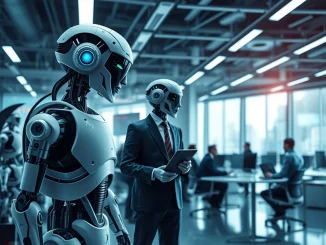
In the fast-paced world of technology, major announcements from industry giants like Microsoft send ripples across the entire digital economy, often influencing investor sentiment even in the cryptocurrency markets. When a company of Microsoft’s stature undergoes a significant strategic shift, it signals broader trends and priorities that can affect everything from cloud computing infrastructure, which many crypto projects rely on, to the very nature of digital innovation. The recent news from Microsoft regarding substantial job cuts and a massive pivot towards artificial intelligence is one such event, prompting a closer look at the future trajectory of tech and its potential implications for the digital landscape.
Why is Microsoft Making This Strategic Shift to AI?
Microsoft CEO Satya Nadella has described the recent workforce reductions as one of the most challenging decisions of his tenure, yet a necessary step for the company’s future. The core reason behind these tough choices is a profound Strategic Shift to prioritize artificial intelligence. Nadella framed the situation as an “enigma of success,” highlighting the paradox of Microsoft achieving record profitability while simultaneously needing to streamline operations for long-term growth and competitiveness. This move is about reallocating resources, not merely cutting costs, to ensure Microsoft remains at the forefront of the rapidly evolving AI landscape. The goal is to enhance agility and focus intensely on AI-driven initiatives, which Nadella believes are crucial for shaping the next era of technology.
Understanding the Scope of Microsoft’s Job Cuts
The scale of the recent workforce adjustments at Microsoft has certainly captured attention. The company has announced nearly Job Cuts totaling 15,000 this year, with a significant 9,000 of those occurring in July alone. While Nadella noted that Microsoft’s total workforce remains “relatively unchanged” due to ongoing hiring in other areas, the concentration of these layoffs in specific departments points to a deliberate restructuring. This approach is common in large tech companies undergoing digital transformation, where efficiency gains in one area are intended to fund innovation elsewhere. However, the human cost is undeniable. The CEO has openly acknowledged the “profound emotional and operational impact” of these decisions, stating they have “weighed heavily” on him and the leadership team. Despite the strategic necessity, these cuts have sparked mixed reactions, with some critics viewing them as a betrayal of employee loyalty, leading to widespread disappointment among affected workers.
Are Microsoft’s Massive AI Investments a Game Changer?
Central to Microsoft’s new direction are its ambitious AI Investments. The company has committed an astounding $80 billion to AI initiatives for 2025, a clear signal of its dedication to leading in this transformative field. This significant financial commitment underscores the belief that AI is not just another feature but the foundational technology for future growth. Microsoft’s vision extends beyond developing tools for specific tasks; it aims to create platforms that empower users to build their own solutions, essentially becoming an “intelligence engine” rather than a traditional software provider. This bold bet on Microsoft AI is designed to solidify its competitive edge, drive innovation, and unlock new opportunities across various sectors, from cloud computing to enterprise solutions and consumer products. The success of these investments will largely determine Microsoft’s trajectory in the coming decade.
How Do These Moves Reflect Broader Tech Industry Trends?
Microsoft’s strategic restructuring is not an isolated incident but rather indicative of broader Tech Industry trends. Across the sector, companies are re-evaluating their operational models, streamlining their workforces, and aggressively investing in AI to stay competitive. This collective pivot highlights a crucial period of transformation, where efficiency and innovation are paramount. The concept of the “enigma of success”—achieving profitability while needing to make difficult operational changes—resonates throughout the industry. Many tech leaders are grappling with the challenge of balancing short-term financial gains with long-term strategic goals and maintaining employee morale amidst rapid change. This period of intense focus on AI signifies a collective understanding that artificial intelligence is no longer a niche technology but a core driver of future economic growth and technological advancement.
What’s Next for Microsoft AI and Its Workforce?
As Microsoft continues its transition, the success of these measures will hinge on their ability to enhance agility and sustain employee morale. Nadella has reiterated Microsoft’s long-standing mission to “empower people and organizations to achieve more,” adapting it to the AI era. This means fostering a culture where innovation in Microsoft AI can thrive, even as the company navigates the complexities of workforce adjustments. While expressing optimism that the restructured workforce will enable greater agility, Nadella has also cautioned that further reductions could occur as market demands shift. The coming months will be critical in testing whether these strategic moves translate into sustained success, solidifying Microsoft’s position as a leader in AI, or if they amplify existing challenges in workforce engagement and market perception. The balancing act between business imperatives and ethical considerations remains a significant challenge for Microsoft and indeed, for many in the tech leadership landscape.
In conclusion, Microsoft’s decision to cut 15,000 jobs while simultaneously making massive investments in AI is a clear signal of its commitment to leading the next wave of technological innovation. This strategic pivot, though challenging for many employees, aims to position the company as an “intelligence engine” for the future. As the tech industry continues its rapid evolution, Microsoft’s bold moves will undoubtedly influence the direction of AI development and the broader digital economy, making it a key player to watch in the years to come.
Frequently Asked Questions (FAQs)
1. Why is Microsoft cutting jobs despite record profits?
Microsoft CEO Satya Nadella described this as an “enigma of success.” Despite strong profitability, the company is undergoing a strategic shift to reallocate resources and prioritize massive investments in AI. The job cuts are part of a broader effort to streamline operations, enhance agility, and ensure long-term competitiveness in the rapidly evolving tech landscape.
2. How many jobs did Microsoft cut this year?
Microsoft has cut nearly 15,000 jobs this year, with 9,000 of those announced in July alone. While the company’s total workforce remains “relatively unchanged” due to ongoing hiring in other areas, these cuts represent a significant restructuring in specific departments.
3. What are Microsoft’s main AI investments?
Microsoft has committed an $80 billion investment to AI initiatives for 2025. These investments are focused on developing advanced AI platforms, fostering an “intelligence engine” vision, and empowering users to build their own AI-driven solutions, moving beyond traditional software provision.
4. How do these changes affect the broader tech industry?
Microsoft’s strategic shift reflects a broader trend across the tech industry where companies are restructuring, streamlining operations, and heavily investing in AI. It signals a collective pivot towards AI as a core driver of future growth and highlights the challenges of balancing profitability with long-term strategic goals and employee morale.
5. What is Satya Nadella’s vision for Microsoft’s future?
Nadella envisions Microsoft evolving into an “intelligence engine” that empowers people and organizations to achieve more through AI. This involves creating robust AI platforms rather than just specific tools, enabling users to innovate and build their own solutions, and maintaining agility in a dynamic market.



